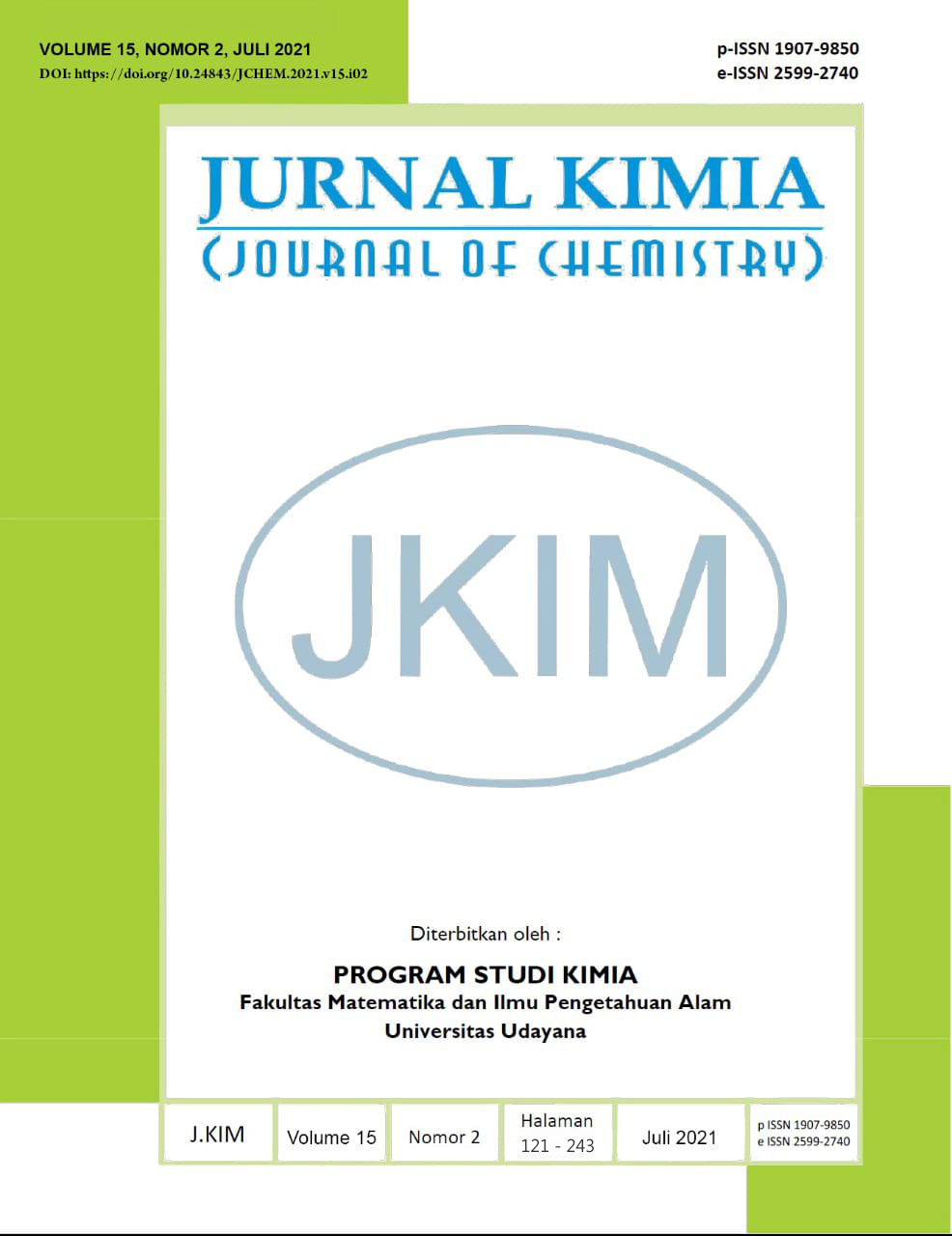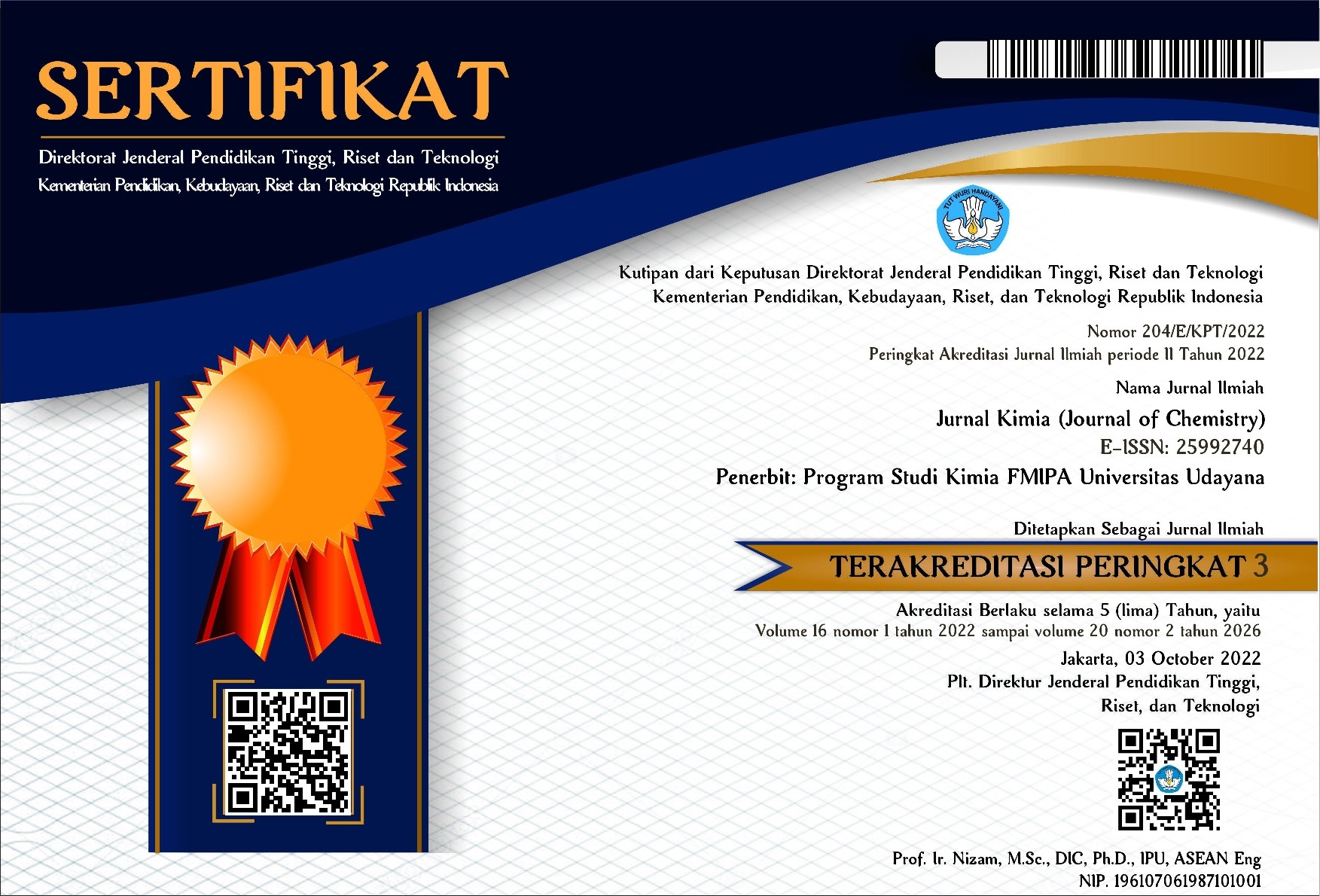THE INFLUENCE OF KCL CONCENTRATION ON ENCAPSULATION EFFICIENCY OF YACON-TUBERS EXTRACT’S CHLOROGENIC ACID
Abstract
Enkapsulasi asam klorogenat ekstrak umbi yakon merupakan salah satu cara untuk melindungi senyawa-senyawa aktif menggunakan paduan polimer alam kappa karagenan-locust bean gum dengan penggunaan ion K+ sebagai pengikat matriks melalui metode gelasi ionik. Pada penelitian ini dilakukan pembentukan gel dari kappa karagenan dan locust bean gum dengan bantuan larutan KCl. Tujuan penelitian ini adalah untuk mengetahui pengaruh konsentrasi larutan KCl pada pembentukan gel serta efektifitas enkapsulasinya. Bertambahnya konsentrasi larutan KCl juga membuat gel menjadi lebih kaku. Hasil uji menunjukkan bahwa penggunaan larutan KCl 0,3M dapat menghasilkan nilai efisiensi enkapsulasi sebesar 79,44%. Kemiripan spektra IR antara gel kappa karagenan-locust bean gum, asam klorogenat murni dan asam klorogenat terenkapsulasi menunjukkan bahwa asam klorogenat hanya terperangkap secara fisik dalam matriks kappa karagenan-locust bean gum dan perubahan spektra karakteristik dari kappa karagenan dari 1018 cm-1 menjadi 1023,62 cm-1 pada sampel hasil enkapsulasi menunjukkan adanya interaksi antara gugus OH dari locust bean gum dan kappa karagenan.
Kata kunci: asam klorogenat; enkapsulasi; kappa karagenan, locust bean gum, Yakon
The encapsulation of chlorogenic acid of yacon tuber extract is one way to protect the active compounds using naturals polymers kappa carrageenan-locust bean gum with K+ ions as a matrix binder through the ionic gelation method. This process was carried out by forming a gel from kappa carrageenan and locust bean gum with the help of KCl solution. This encapsulation process has purposes to determine the effect of the concentration of KCl solution on gel formation and the effectiveness of its encapsulation. The test results indicated that the use of 0.3M KCl solution resulted in an encapsulation efficiency value of 79.44%. The bonding between the two polymers and the K+ cation was thought to result in a higher encapsulation effectiveness. The similarity of IR spectra among kappa carrageenan-locust bean gum gel, pure chlorogenic acid and encapsulated chlorogenic acid showed that chlorogenic acid was only trapped physically in the kappa carrageenan-locust bean gum matrix and the shift of kappa carrageenan peak from 1018 cm-1 to 1023,62 cm-1 of the encapsulated sample had shown an interaction between OH groups from locust bean gum and kappa carrageenan.
Keywords: chlorogenic acid; encapsulation; kappa carrageenan, locust bean gum, Yacon
Downloads
References
Audet, P., Paquin, C. and Lacroix, C. 1991. Effect of medium and temperature of storage on viability of LAB immobilized in k-carrageenan-locust bean gum gel beads. Biotechnology Techniques. 32.
Cerqueira, M. A., Souza, B. W. S., Simões, J., Teixeira, J. A., Domingues, M. R. R. M., Coimbra, M. A. 2011. Structural and Termal Characterization of Galactomannans from Non-Conventional Sources. Carbohydrate Polymers. 83(1): 179-185.
Distantina, S., Fadilah; Rochmadi., Fahrurrozi., Moh., Wiratni. 2010. Proses Ekstraksi Karagenan dari Eucheuma cottonii. Seminar Rekayasa Kimia dan Proses. Solo: Universitas Sebelas Maret.
Dubey, R., Shami, T. C. and Rao, K. U. 2009. Microencapsulation Technology and Applications Vol 59JO. Defence Science Journal.
Dunstan, D. E., Chen, Y., Liao, M L., Salvatore, R., Boger, D V., Prica, M. 2001. Structure and Rheology of the K-Carrageenan/Locust Bean Gum. Food Hydrocolloids, (XV): 475-484.
FCC, 1997. Food Chemical Codex. Institute of Medicine Washington DC.
Glickman, 1983. Food Hydrocolloid vol 1I. Florida: CRC Press Inc Boca Raton.
Goncales, E. J. D., Felicio, M. M., Pinto, M. H., Rossi, C., Medina, M J B., Fernandes, eIC., Simoni. 2003. Inhibition of Aflatoxin Production by Polymnia sonchifolia and its in Vitro Cytotoxicity. Arq. Inst. Biol. 70(2): 159-163.
Guzman, N., Munos, L. and Bahamon, A. 2018. ATR-FTIR For Disc Rimenation of Espresso and Americano Coffee Pods. Research Gate. 550-558.
Johnson, R., Perez-Posa, S E., Sautin, Y Y., Manitius, J., Lozada, L G., Feig, D I. 2009. Hypothesis: Could excessive fructose intake and uric acid cause type 2 diabetes. Endocr Rev. 30(1): 96-106.
Johnston, K. L., Clifford, M. N., and Morgan, L. M. 2003. Coffee acutely modifies gastrointestinal hormone secretion and glucose tolerance in humans: glycemic effects of chlorogenic acid and caffeine. [Online]
Available at: https://www.ncbi.nlm.nih.gov/pubmed/14522730
[Accessed 29 December 2019].
Kailasapathy, K., 2002. Microencapsulation of probiotic bacteria: technology and potential applications. Curr. Issues Intest. Microbiol. 3(2): 39-48.
Kayaa, A. O. W., Suryanib, A., Santoso, J. and Ruslid, M. S. 2015. The Effect of Gelling Agent Concentration on the Characteristic of Gel Produced From the Mixture of Semirefined Carrageenan and Glukomannan. International Journal of Sciences: Basic and Applied Research (IJSBAR). 20: 313-324.
Krasaekoopt, W., Bhandari, B. and Deeth, H., 2003. Evaluation of encapsulation techniques of probiotics for yoghurt. Int. Dairy J. 13(1): 3-13.
LIANG, N. E. A. 2016. Application of attenuated total reflectance-Fourier transformed infrared (ATR-FTIR) spectroscopy to determine chlorogenic acid isomer profile and antioxidant capacity of coffee beans. Journal of Agricultural and Food Chemistry, 64: 681–689.
Manrique, I., Hermann, M. and Bernet, T., 2004. Yacon- Fact Sheet. Peru: International Potato Center (CIP) Lima.
Martins, J. T., Cerqueira, Miguel A., Bourbon, Ana I., Pinheiro, Ana C., Souza, Bartolomeu W.S., Vicente, António A. 2012. Synergistic Effects Between K-carrageenan and Locust Bean Gum. Food Hydrocolloids. 29: 280-289.
Masakuni, T. and Nakamura, S. 1986. Synergistic Interaction between Kappa-Carrageenan and Locust-bean Gum in Aqueous. Agric. Biol. Chem.
Murdinah, Sinurat, E. and Utomo, B. S. B. 2006. Sifat Fungsional Formula Kappa dan Iota Karaginan Dengan Gum. Jurnal Pascapanen dan Bioteknologi Kelautan dan Perikanan.
Ning, W., Jiugao, Y., Xiaofei, M. and Ying, W. 2007. The Influence of Citric Acid on the Properties of Thermoplastic Starch/Linear Low-density Polyethylene Blends. Carbohydrate Polymers. 67(3), pp. 446-453.
Pelissari, F. M., Grossmann, M. V. E., Yamashita, F. and Pineda, E. A. G., 2009. Antimicrobial, Mechanical, and Barrier Properties ff Cassava Starchechitosan Films Incorporated with Oregano Essential Oil. Journal of Agricultural and Food Chemistry. 57: 7499-7504.
Schaller, C. 2020. Libre Texts. [Online]
Available at: https://chem.libretexts.org/Bookshelves/Organic_Chemistry/Book%3A_Polymer_Chemistry_(Schaller)/04%3A_Polymer_Properties/4.08%3A_Storage_and_Loss_Modulus
[Accessed 6 October 2020].
Shi, Lu- E., Li, Zhen-Hua., Zhang, Zhi-Liang., Zhang, Ting-Ting., Yu, Wei-Ming. 2013. Encapsulation of Lactobacillus Bulgaricus in Carrageenan-locust Bean Gum Coated Milk Microspheres With Double Layer Structure. LWT - Food Science and Technology. 54: 147-151.
Stading, M. and Hermansson, A.-M. 1995. Rheology and Microstucture of Mixed K-Carrageenan - Galactomannan Gels. Annual Transactions of the Nordic Rheology Society. 3.
Tecante, A. and Santiago, M. d. C. N. 2012. Rheology. Rijeka: InTech.
Tetance, A. and Santiago, M. d. C. N., 2012. Solution Properties of κ-Carrageenan and Its Interaction with Other Polysaccharides in Aqueous Media. https://www.intechopen.com/books/rheology/solution-properties-of-k-carrageenan-and-its-interaction-with-other-polysaccharides-in-aqueous-media.
Ulfah, M. 2009. Pemanfaatan Iota Karaginan (Eucheuma spinosum) dan Kappa Karaginan (Kappaphycus alvarezii) Sebagai Sumber Serat Untuk Meningkatkan Kekenyalan Mie Kering. Bogor: Institut Pertanian Bogor.
Wanchoo, R. K. and Sharma, P. K. 2003. Viscometric Study on the Compatibility of Some Water-Soluble Polymerepolymer Mixtures. European Polymer Journal. 39(7): 1481-1490.
Yan, X. J., Suzuki, M., Obnishi-Kameyama, M., Sada, Y., Nakanikshi, T., Nagata, T. 1999. Extraction and Identification of Antioxidants in the Root of Yacon (Smallanthus sonchifolius). Journal of Agricultural and Food Chemistry. 47(11): 4711-4713 .
Zobel, J. and Talbert. 2007. Applied forest tree improvement: wood and tree improvement. New York: John Willey & Sons, Inc.

This work is licensed under a Creative Commons Attribution 4.0 International License






